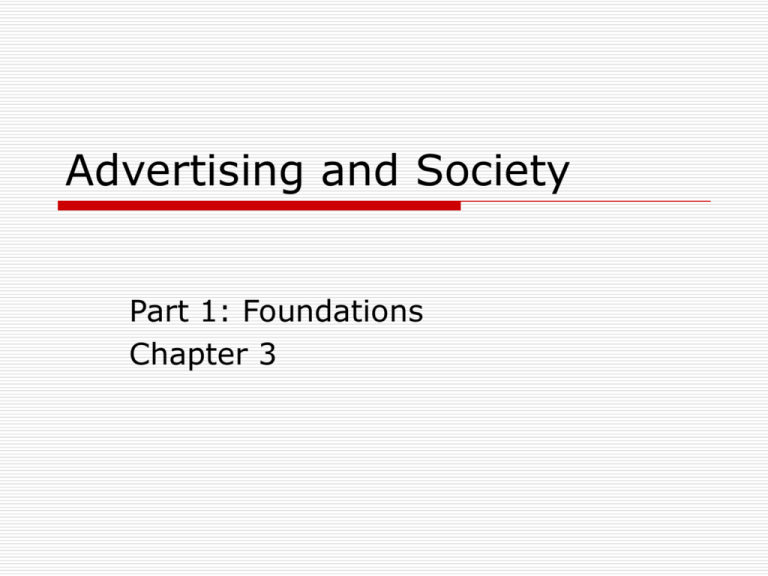Advertising and Society
advertisement

Advertising and Society Part 1: Foundations Chapter 3 Key Points Discuss the shape-versus-mirror debate Analyze the legal topics that guide advertising practice List the key regulatory agencies and their responsibilities Explain the way the advertising industry regulates itself Critique the key ethical issues that challenge the practice of advertising Outline three ways to determine if an advertising decision is ethical 2 Advertising’s Societal Role Does advertising create a materialistic culture or does it simply reflect it? Critics believe that advertising has the power to shape social trends and the way people think and act Advertising professionals believe advertising mirrors values rather than sets them Advertising can potentially shape and mirror values 3 Review and Regulation of Advertising Copyright Protection Trademark Copyright First Amendment Commercial speech Only truthful commercial speech is protected, not misleading or deceptive statements 4 Advertising’s Regulatory Environment Federal Trade Commission Regulating deception Regulating substantiation Remedies for deception and unfair advertising Deceptive advertising misleads customers by making claims that are false 5 Advertising’s Regulatory Environment Federal Trade Commission Regulating deception Regulating substantiation Remedies for deception and unfair advertising The advertiser should have a reasonable basis for making a product claim 6 Advertising’s Regulatory Environment Federal Trade Commission Regulating deception Regulating substantiation Remedies for deception and unfair advertising Consent Decrees Cease-and-Desist Orders Corrective Advertising Consumer Redress Advertising Agency Legal Responsibility 7 Advertising’s Regulatory Environment Food and Drug Administration Oversees package labeling, ingredient listings, and advertising for food and drugs Watchdog for drug advertising Federal Comm. Commission Can issue and revoke licenses to broadcasting stations Can ban messages that are deceptive or in poor taste 8 Advertising’s Regulatory Environment Other Regulatory Bodies Bureau of Alcohol, Tobacco, and Firearms U.S. Postal Service States’ Attorneys General International Regulations Marketing practices vary in legal and regulatory restrictions International advertisers should have someone in the country who knows the local laws 9 Media Review of Advertising The media attempts to regulate advertising by screening and rejecting ads The First Amendment gives any publisher the right to refuse to publish The Advertising Review Council designed the standards and guidelines used by major television networks 10 Self-Regulation Self-discipline Industry selfregulation Selfregulation with outside help Most advertisers and agencies have in-house review procedures Every element of a proposed ad should be evaluated by an in-house committee or lawyers 11 Self-Regulation Self-discipline Industry selfregulation Selfregulation with outside help National Advertising Review Council National Advertising Division National Advertising Review Board Negotiates voluntary withdrawal of deceptive advertising 12 Self-Regulation Self-discipline Industry selfregulation Selfregulation with outside help Local Groups Consumer Groups 13 Question to Ponder Is self regulation really in the best interests of the advertising industry? Is self regulation motivated by benevolence or business sense? 14 Advertising Ethics A set of moral principles that guide actions and create a sense of responsible behavior Six key issues 1. Poor taste and offensive advertising 2. Stereotyping 3. Body and self image 4. Targeting children 5. Misleading claims and other message strategies 6. Controversial products 15 Advertising Ethics Poor Taste/Offensive Advertisers and media outlets must try to be sensitive to consumer objections Creating guidelines for good taste is difficult Sex in advertising 16 Advertising Ethics Reinforcing Stereotypes Diversity Issues Gender Roles Racial and Ethnic Stereotypes Senior Citizens Body and Self Image Self-image advertising can contribute to selfimprovement Can also lead to dangerous practices Advertising mirrors and shapes the standard of attractiveness 17 Advertising Ethics Children One of the most controversial topics in the industry Children are unable to evaluate advertising messages and make purchasing decisions 18 Advertising Ethics Misleading Claims Advertising claims are unethical if they are false, misleading, or deceptive 19 Advertising Ethics Controversial Products Though it is acceptable to advertise these products, it is still offensive to some 20 Determining What is Ethical The social ethic The professional ethic The personal ethic The “Golden Rule” Social responsibility motivates a business to make a positive impact on society 21 Determining What is Ethical The social ethic The professional ethic The personal ethic Industry standards help with a decision about what is ethically correct A code of standards identifies how professionals should respond when facing an ethical dilemma 22 Determining What is Ethical The social ethic The professional ethic The personal ethic Personal judgment and moral reasoning rests on an intuitive sense of right and wrong Advertising professionals must be aware of industry standards as well as ethical questions 23

